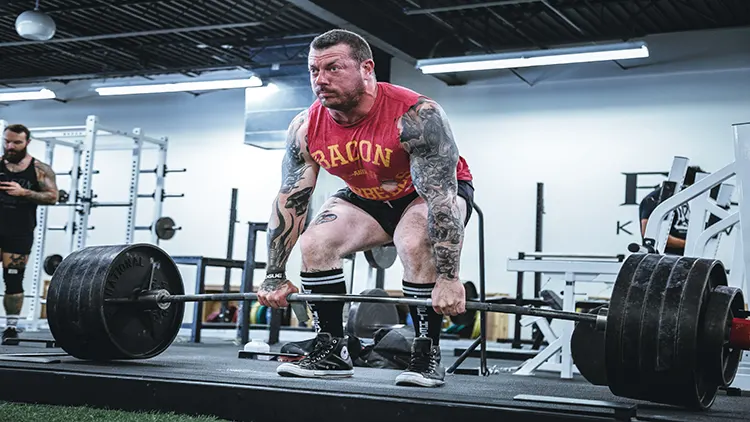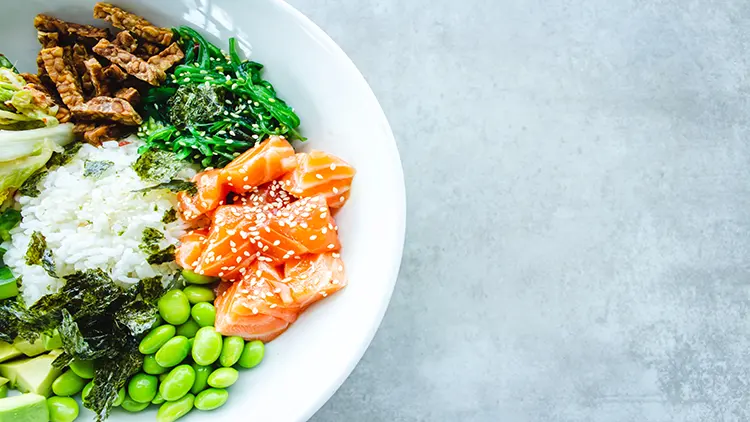
Building muscle on maintenance calories is challenging and typically requires special conditions such as being a beginner, returning to training after a break, or using performance-enhancing substances. Generally, significant muscle gains often necessitate a calorie surplus rather than maintaining intake. So in most cases, don’t even try building muscle while eating maintenance calories and get use to bulking and cutting for optimal results.
Now that we got that out of the way, continue reading to see when to eat maintenance calories, how many calories above maintenance you should be eating, how much muscle can be gained with bulking, and how to bulk and cut like the pros so you can stack on pounds of pure muscle mass in the same way full-time bodybuilders do.
Building Muscle on Maintenance Calories: Is It Achievable?
As hinted at in the intro, it is possible to build muscle while eating maintenance calories but only in certain cases; plus it’s not very effective. In fact, most people who have been weight training for a few months and beyond might see no muscular gain under a maintenance diet.

Source: Alora Griffiths from Unsplash1
Building Muscle on Maintenance Calories
Although unlikely for most, it is possible to gain or build muscle on maintenance calories but only in certain instances such as just beginning a strength routine, starting to train once again, and when supplementing with performance enhancing drugs. It is important to remember that even though someone may fit into one of these categories, as training continues, the rate of muscle gain will dramatically decrease and may even come to a complete stop.
As a Beginner Lifter Body Recomposition Is Possible on Maintenance Calories
When beginning any fitness plan, it is common to see results very quickly. This is because the nervous system isn’t efficient at moving muscles in new ways; therefore, even while eating to maintain weight, there will still be muscle growth.2 This neural development typically lasts roughly 8 weeks, but is then followed by hypertrophy, which is the actual growth of the cells in the muscle.
For those new to lifting or in a beginner hypertrophy program, muscle building is in overdrive and can stay that way anywhere from a few months all the way up to one year.3 This phenomenon is commonly referred to as newbie gains and as the body builds endurance to workouts, progress will slow dramatically.
When You’re Getting Back Into Training (When Lean Bulks Can Work)
Just as with beginners, taking a break from lifting weights can temporarily cause muscle memory to wane. What this means is, that when someone ceases working out for a time, the nervous system loses some of the functionality it initially gained.
The difference between those who have taken a break and those who are just starting is that anyone getting back into lifting will have a shorter span of neural development, therefore, causing a smaller window of dramatic results as comparable to someone just beginning.
If You Take Performance Enhancing Drugs
Performance enhancing drugs, specifically anabolic steroids, are typically taken by athletes that are looking to quickly gain and retain muscle as well as enhance their athletic performance. Instead of counting on the body to produce the testosterone naturally it needs to build muscle, this drug is used to mimic its effect, but at a much greater level.4
It is very important to understand that, while there are appropriate medical uses for anabolic steroids, bulking up is not one of them. It is critical to only take anabolic steroids for diagnosed reasons and only under a doctor’s close supervision.
Improper use of these performance enhancing drugs may cause issues that aren’t only limited to the following:
- Heart Disease
- Cardiomyopathy
- Hypertension
- Lower HDL Cholesterol
- Testicular Pain and Atrophy
- Prostate Carcinoma
- Skin Blisters
- Aggression
When Is Eating Maintenance Calories Recommended for Building Muscle or Hypertrophy?
Typically, eating at a surplus is the ideal way of adding on muscles, which will be expanded on in coming sections, but eating at maintenance calories to build muscle can be recommended for specific occasions.
Eating at Maintenance Calories During Time Off
Whether time off is planned or unexpected, choosing to eat at maintenance while traveling for work, on vacation, during a holiday, or while navigating a life event can help the body retain the muscle it has already gained. The alternative, which is going into a calorie deficit during this time, will not only burn fat, but also a percentage of muscle that was so skillfully gained.
Choosing a caloric goal that doesn’t add or burn energy can guarantee that when it is time to hit the gym hard to continue bulking up, there will be minimal time wasted re-earning gains.
Eating at Maintenance Calories at Goal
Hitting a goal and reaching a desired physique is an exciting time for any athlete. Maintaining this desired body means finding and sticking with the perfect amount of calories so burning through muscle mass as well as gaining fat are both avoided.
Taking into account daily and weekly workout goals along with calories burned can help determine the amount of calories a subject needs to eat to maintain their weight, thereby holding on to their drool-worthy muscles or achieving small, technical gains.
How Many Calories Above Maintenance Are Needed to Build Muscle?
There are many studies, tables, and advice in books and all throughout the internet that give suggestions on how many calories over maintenance should be eaten to build muscle. Instead of spending countless hours pouring through these documents to try and find the perfect equation, it is important to realize that each individual is different and these caloric estimates may be off by 10’s or 100’s of calories.
These tables and charts have no ability to account for starting body composition, the exact amount of energy burned while resistance training, or the amount of muscle gained while training.5
That being said, many suggest a surplus of 100-250 calories at first, and if no weight is gained in two weeks, add another 100-250 calories per day. But this is just one approach.

Source: Dollar Gill from Unsplash6
However, there’s a better way than guesstimating and a straightforward equation along with consistently tracking weight is the foolproof way to determine whether or not the correct amount of calories are being consumed.
What Equation Should I Use To Estimate a Calorie Surplus?
A majority of caloric estimates for muscle gain start with BMR (Basal Metabolic Rate) and then multiply by a certain percentage to attain a surplus. To get a ballpark figure similar to these estimates, consider using the following:
Current Weight (in pounds) X 12 to15 (This number can be adjusted daily to account for training intensity) = Daily Maintenance Calorie Target
Daily Maintenance Calorie Target X 10% = Daily Surplus Calorie Target
For example; if an individual weighs 200 pounds and is performing an intense workout, they can can insert their details in the above formulas, which works out as follows:
200 Pounds x 15 (Due to the intensity of the workout) = 3,000 Calories (Daily Maintenance Calorie Target)
3,000 Calories X 10% = 3,300 Calories (Daily Surplus Calorie Target)
Therefore, a 200 pound athlete looking to gain muscle can begin by estimating their target surplus calories at 3,300. To reiterate, it is imperative to remember that this is just a starting point at which to base calories.
Weighing throughout the week to track gains will be the benchmark to use to adjust caloric needs.
Gains should fall between .25 and .5 percent of bodyweight per week. If the scale falls below or above that amount, that is the indication that calorie intake should either be increased or decreased to achieve the weight target.7
How Much Muscle Growth is Possible on Maintenance Calories?
The extent to which someone can gain muscle while maintaining their calorie intake varies significantly depending on their stage in their fitness journey.
Those starting a strength routine may expect to gain up to 2% or more of their body weight per month for the first few months depending on their routine until muscles build up endurance. From that point on, the rate of muscle gain will drastically decrease and can reach significantly below 1% of bodyweight per month.
What this means is that a 200 pound intermediate athlete eating at maintenance calories could struggle to even gain half a pound of muscle in a month while a beginner at that same weight may gain 4 or more pounds in 30 days.
Can You Build Muscle While Maintaining Your Caloric Intake?
After confirming that muscle growth can occur on maintenance calories under specific conditions, one might consider the feasibility of building muscle in a calorie deficit.
Muscles still rely on calories to function and rebuild, but building muscle tone is one of the body’s lowest priorities with a majority of energy consumption going to basic functions such as controlling heart and brain operation, circulation, digestion, etc. Therefore, if eating at a calorie deficit, the body will prioritize these functions before increasing muscle mass.7
Beginners may see an increase in muscle mass even when on a calorie deficit for a short amount of time due to the newbie gain phenomenon. However, for experienced lifters in particular, they will be expending great amounts of energy for miniscule results, if any.
A Better Approach to Building Muscle: Massing Phases (Calorie Surplus) Offset by Occasional Fat Loss Phases (Calorie Deficit)
Taking a phasic approach to building muscle is a tried and true method tested by professional bodybuilders and powerlifters and is known as bulking and cutting – or mass phase and fat loss phase. Or in other words, putting pounds on for the purpose of gaining muscle (with some fat gain), and then leaning down while trying to avoid any muscle loss.

Source: Louis Hansel from Unsplash8
This can typically be done in three phases: one that includes a defined time period of eating at a calorie surplus, a strategically planned fat loss stage to counteract unwanted fat gains, and a maintenance period.9
Massing Phase:
During a massing phase, focus will be on building muscles. Because it has been proven that trying to gain muscle mass while on calorie maintenance or deficit is unproductive, this cycle will be dedicated to eating at a caloric surplus to guarantee muscles are getting the energy needed to rebuild at their peak efficiency.
It is impossible to direct every calorie eaten to muscle growth, so it can be expected to have some weight gain from fat. While this may seem intimidating and counterintuitive to working out, it is a necessary evil to achieve gains at lightning speed.
Fat Loss Phase:
Thankfully, because muscle building pioneers have already done the hard work and research, we know to cycle in fat loss phases to kick any fat gains to the curb. This stage will be dedicated to getting rid of excess weight that was either gained while bulking or that has settled on the body previous to working out.
Maintenance Phase:
Unbeknownst to many, adding a maintenance phase to long term workout schedules can be extremely beneficial. This period of time allows the body to physically and mentally recover from a massing phase while preparing it for a fat loss phase.
Without this allotted time, it is easy to fall into overtraining or get burnt out and give up.
How To Bulk & Cut Like the Pros
Coming up with a periodization schedule like the pros can help anyone who desires to bulk up their muscles and trim down their waistline. The following schedule is a guideline that can be adjusted based on lifestyle changes and needs as well as goals and desired results.
1. Massing Phase (Calorie Surplus)
A massing or bulking phase typically lasts 10 to 16 weeks. This time is meant to focus on a high volume of sets that include 6 to 12 repetitions each.
To maximize hypertrophy during this phase, as mentioned before it is crucial to give the body the energy it needs and also promote beneficial hormonal reactions through a hypercaloric diet.
Once a daily calorie intake goal based on the Daily Calorie Surplus Target laid out earlier in this article is determined, it is equally important to further establish the ideal amount of macros needed to amplify results.
- Protein: Muscles are made primarily of protein, so it comes as no surprise that protein is required to build muscle. Muscle Protein Synthesis is the mechanism in which muscles repair themselves after being broken down during a workout. To complete this process, a significant amount of protein must be introduced through diet. The body prioritizes protein intake just as it does calorie intake, and muscle building is at the bottom of the list, so ensuring the right amount is critical.
- Carbohydrates: Not having enough glycogen stores (energy from carbohydrates) can greatly diminish training as well as recovery. Ensuring enough carbohydrates are consumed, especially on heavy workout days, will increase hormonal benefits as well as improve energy output.
- Fat: As noted of other nutrients, fat also plays a significant role when it comes to hormones, especially testosterone. Cutting out fat from a diet completely is bad news and can be harmful, so ensuring a minimum amount of fat is added into a bulking diet is vital.
The following chart gives the suggested amount of protein, fat, and carbohydrates that should be aimed for during a massing phase. The protein and fat suggestions should be prioritized, while the carbohydrate amount can be adjusted to cover remaining calories in a day.
Suggested Macros for Massing Phase
| Macros | Grams per 1 Pound of Bodyweight |
| Protein | 1 Gram |
| Fat | .25 to .35 Grams |
| Carbohydrates | 2 Grams7 |
During this phase, adjustments can be made based on periodic results. As touched on earlier, calories can be increased if weight or strength gains are not being met.
Subsequently, calories can be decreased or training can be ramped up if too much weight is being gained.
2. Maintenance Phase (Calorie Maintenance)
Massing or hypertrophy phases are hard on the body, so instead of carrying on at an unrealistic pace, taking around 4 weeks to let the body and mind recover is just as important as the time spent to build and harden muscles.
As the name of this phase depicts, this is the ideal time to eat at maintenance. Building muscle on maintenance calories isn’t highly feasible, but it’s unlikely to lose muscle if you’re training properly and maintaining your calorie intake.
To properly train during maintenance, lower the volume and boost the weight. Focus on strength by lowering the amount of sets to 3 with 5 repetitions each and recharge and prepare for the impending cut phase.9
Increasing fat and reducing carbohydrates will not only help maintain weight, but also keep hormones balanced, which is also critical to muscle maintenance during a maintenance period.10
Suggested Macros for Maintenance Phase
| Macros | Grams per 1 Pound of Bodyweight |
| Protein | 1 Gram |
| Fat | .55 to .65 Grams |
| Carbohydrates | 1 to 1.3 Grams |
3. Cut Phase (Calorie Deficit)
During this 3 to 8 week phase is the time to target any extra fat that is either hanging around or that was gained during the massing phase. Because of the order of phases, there is a step down from the large amount of calories consumed during a bulk to the maintenance phase and ultimately to a calorie deficit.
Rushing a cut can cause unwanted loss of muscle mass and a feeling of deprivation. Instead, set a goal to lose .5 to 1 percent of body weight per week during the allotted time frame, which is about a 500 to 1000 calorie deficit per day.
This deficit can be achieved through a combination of eating less and increasing workout intensity. Cardio can be a great supplement to resistance training during these times as it can burn a high amount of calories in a short period.
The biggest thing to consider during a cut is to lose the least amount of muscle mass possible. To achieve this, slightly increasing protein and fat macros while decreasing carbohydrates is ideal.
Suggested Macros for Cut Phase
| Macros | Grams per 1 Pound of Bodyweight |
| Protein | 1 to 1.4 Grams |
| Fat | .45 Grams |
| Carbohydrates | 1 Gram |
Most training to aspire big muscle gains are looking for the most effective and efficient way of achieving a successful bulking routine. While it may appear counterproductive, building muscle on maintenance calories is limited. However, following a phased approach that includes distinct bulking, maintenance, and cutting phases can deliver the desired results for resistance trainees quickly.
References
1Alora Griffiths. “black adjustable-weight barbell photo – Free Athletic Image on Unsplash.” Unsplash, 15 August 2018. Accessed 11 April 2023. <https://unsplash.com/photos/E3wehabi_B4>
2Sale, D. G. (1988, October). Neural adaptation to resistance training. PubMed. Retrieved January 6, 2023, from <https://pubmed.ncbi.nlm.nih.gov/3057313/>
3Haug, W. (2011, May 2). Predictors in Strength Gains in Untrained Men Over 9 Months of Training. OpenCommons@UConn. Retrieved January 6, 2023, from <https://opencommons.uconn.edu/cgi/viewcontent.cgi?article=1074&context=gs_theses>
4Ganesan, K., Rahman, S., & Zito, P. M. (2022, August 25). Anabolic Steroids – StatPearls. NCBI. Retrieved January 9, 2023, from <https://www.ncbi.nlm.nih.gov/books/NBK482418/>
5Slater, G. J., Dieter, B. P., Marsh, D. J., Helms, E. R., Shaw, G., & Iraki, J. (2019, August 20). Is an Energy Surplus Required to Maximize Skeletal Muscle Hypertrophy Associated With Resistance Training. NCBI. Retrieved January 10, 2023, from <https://www.ncbi.nlm.nih.gov/pmc/articles/PMC6710320/>
6Dollar Gill. “a shirtless man in a gym holding a barbell photo – Free Exercise Image on Unsplash.” Unsplash, 14 December 2021. Accessed 11 April 2023. <https://unsplash.com/photos/PsuIO9XGhr8>
7Israetel, M. (2023, January 6). Calories and Macros for Muscle Gain. YouTube. Retrieved January 10, 2023, from <https://www.youtube.com/watch?v=gcUXMW0sWBA&t=6s>
8Louis Hansel. “cooked food photo – Free Food Image on Unsplash.” Unsplash, 14 April 2019. Accessed 11 April 2023. <https://unsplash.com/photos/phEaeqe555M>
9MacCormick, T., Luoma, T., & Birch, S. (2017, October 16). The Complete Guide to Bulking and Cutting. T-Nation. Retrieved January 10, 2023, from <https://www.t-nation.com/lean-built-eating/the-complete-guide-to-bulking-and-cutting/>
10Whittaker, J., & Wu, K. (2021, March 16). Low-fat diets and testosterone in men: Systematic review and meta-analysis of intervention studies. PubMed. Retrieved January 10, 2023, from <https://pubmed.ncbi.nlm.nih.gov/33741447/>